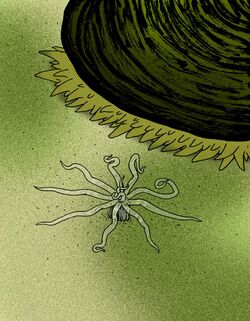Biology:Ivell's sea anemone
| Ivell's sea anemone | |
|---|---|

| |
| Artist's image of the living animal | |
| Scientific classification | |
| Domain: | Eukaryota |
| Kingdom: | Animalia |
| Phylum: | Cnidaria |
| Class: | Hexacorallia |
| Order: | Actiniaria |
| Family: | Edwardsiidae |
| Genus: | Edwardsia |
| Species: | E. ivelli
|
| Binomial name | |
| Edwardsia ivelli Manuel, 1975[2]
| |
Ivell's sea anemone (Edwardsia ivelli) is a species of sea anemone in the family Edwardsiidae.[3] It is endemic to a single location, Widewater Lagoon in West Sussex, England, where it was first discovered by Richard Ivell.[2] It has been listed as Data Deficient by the IUCN since 1996.[1]
Description
Ivell's sea anemone is a tiny, worm-like anemone up to 20 mm (0.79 in) long and 1.5 mm (0.059 in) diameter; the column is similar to other Edwardsia spp. There are twelve transparent tentacles, arranged in two cycles, nine tentacles in the outer cycle and three in the inner cycle. In life the tentacles of the outer cycle are held flat on the substrate, the three of the inner cycle more or less vertical, often curled over the mouth. Each tentacle has a few transverse bars of pale cream occasionally forming complete rings.[citation needed]
Habitat and distribution
Burrowing in soft mud in saline lagoons or sheltered creeks, it is a tiny species and easily overlooked unless deliberately sought.
It is endemic to England known from only one site, Widewater Lagoon in West Sussex, the type locality. Searches in recent years have failed to find any specimens and the species is considered extinct by some conservationists [4]
Similar species
Although the type of locality inhabited by this species is not often searched by divers, such places are well-worth investigating. This species and Nematostella vectensis are probably the only British Anthozoans which can be considered endangered species through habitat destruction and pollution.[citation needed]
Ivell's sea anemone was discovered by Professor Richard Ivell, hence the species' name.[2]
References
- ↑ 1.0 1.1 Macadam, C. (2022). "Edwardsia ivelli". IUCN Red List of Threatened Species 2022: e.T7035A200286264. https://www.iucnredlist.org/species/7035/200286264. Retrieved 3 August 2022.
- ↑ 2.0 2.1 2.2 Manuel, R.L. (1975). A new sea anemone from a brackish lagoon in Sussex, Edwardsia ivelli, sp. nov. Journal of Natural History, 9, 705-711.
- ↑ Fautin, D. (2011). "Edwardsia ivelli Manuel, 1975". WoRMS. World Register of Marine Species. http://www.marinespecies.org/aphia.php?p=taxdetails&id=100888.
- ↑ Jackson, Angus. "Ivell's Sea Anemone". The Marine Biological Association of the UK. https://www.marlin.ac.uk/species/detail/1140.
Wikidata ☰ Q2124204 entry
 |


